Tools for Sawing
There are two types of crosscut saws. Symmetric crosscut saws are designed for a sawyer at each end, and asymmetric saws require only one sawyer. They are heavier so they can be pushed and pulled without buckling. There are two basic patterns for symmetric crosscuts—felling crosscuts are light, flexible, and have concave backs that conform easily to the arc of the cut and the sawyer's arm. The narrowed distance between the teeth and back helps sawyers wedge the cut quickly. Felling saws are usually preferred by trail crews. Bucking crosscuts have straight backs and are heavier and stiffer than felling saws. Their weight helps the saw cut faster and the stiffness prevents buckling on the push stroke when one person saws. Most asymmetric saws are bucking saws. Symmetric saws are pulled by each sawyer. There is no push stroke.

Crew members using a
bucking
crosscut saw.
Types of crosscut saws

Symmetric saw
The points of most crosscut saw teeth lie on the arc of a circle. These cut easier than a straight-tooth saw and are almost as simple to maintain. Crosscut blades are ground flat or ground with a taper from front to back. A flat-ground blade displays uniform thickness throughout. Flat-ground saw teeth require more "set" than taper-ground saw teeth.

1—A cut made with flat-ground teeth tends
to bind when cutting
under compression.
2—A cut made by taper-ground teeth
is
less
likely to bind.
Taper-ground saws vary from thick-at-the-teeth to thin-at-the-back so their teeth require less set. Taper-ground saws work well for trail jobs because they begin cuts quickly and are slower to bind than flat-ground saws. For all-around trail use, a taper-ground felling crosscut is very effective. Taper-ground saws are often called crescent, precision, segment, or arc-ground saws.
- Each
line represents uniform thickness—tapering
from thicker at the teeth to thinner at the top. - The teeth are a uniform thickness.

- The teeth may vary in thickness
One-person saw blades vary from 3 to 4½ feet and these saws weigh 4 to 5 pounds. Two-person saws generally have 6-foot blades and weigh about 8 pounds.
Many modern crosscuts have solid ends. That is, the teeth do not extend to the ends of the blade. For finishing some cuts, however, you will often need a saw with teeth continuous to both ends. A saw with continuous teeth is needed to cut a log in dirt or deep duff, for example.
Before sawing a log with a crosscut, "swamp" the area to remove materials that could interfere with the cut. Next, check the "lay of the log" to determine what will happen when the cut is made. Saw from the uphill side unless you are placing an undercut on a standing tree. Remove loose bark from the line where the saw will pass. Avoid getting the saw into the dirt at the end of the cut. If necessary, place a piece of bark under the log or dig it free under the cut. Make final strokes with one end of the saw so only end teeth will dull if you slip.
When carrying a saw, lay it flat across one shoulder with the teeth guarded and facing away from the neck. Carry the saw on the downhill shoulder. Grasp the front handle from under the blade. Remove the rear handle to prevent snagging on overhanging limbs. Transport saws at the rear of a line of workers. Use blade guards made of sections of rubber-lined firehose slit lengthwise with Velcro fasteners to facilitate removal. Saws need extra protection when they are transported in a vehicle. They should be secured between pieces of plywood cut to blade width, or otherwise protected. Store saws straight. Either hang them or lay them flat. Storing saws in a bent position can bow the saw. Before storing, the blade should be coated with a protectant to prevent corrosion. Never store a saw in a wet sheath.
A sharp crosscut is a pleasure to operate, but a dull or incorrectly filed saw is a source of endless frustration. Quality crosscut saw filers are increasingly difficult to find. Good instruction for crosscut saw filing is still available, however. We recommend The Crosscut Saw Manual by Warren Miller (Tech. Rep. 7771-2508-MTDC, rev. 2003). The manual discusses in detail how a saw works and offers experience-tested methods for choosing, using, and maintaining a saw. Copies are available from MTDC.
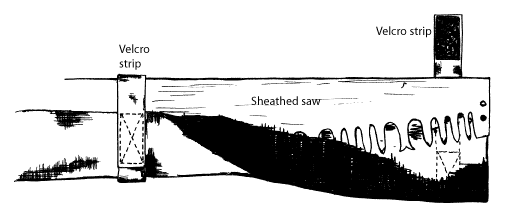
A crosscut saw sheathed with a piece of fire hose.
Tree sap may bind the crosscut blade in the cut. To prevent this, lightly lubricate the blade with a citrus-based solvent. If a flask is stoppered with a cork that has been grooved lengthwise, the blade can be evenly coated with a film of citrus-based solvent by inverting the flask and whisking the cork along the blade surface. An alternative would be a squirt bottle of citrus-based solvent that could spread a small stream of the fluid along the blade.
A leaning tree will have compressed fibers on its underside. In this case, a cut on that side could quickly bind a saw even after it has been undercut. If this happens, saw as much as possible, remove the saw, and chop away the severed wood. A down log can be under compression if it is only supported on the ends. A cut made in the middle will bind the saw as the weight of the log closes the kerf. Sometimes a cut can be continued by driving a wedge into the cut behind the saw. If the saw still binds, one sawyer should "underbuck" the log from the bottom. Remove one handle to reduce the chance of the blade "kinking" if the severed log carries it to the ground. Plant an ax in the log so the handle can support the back of the saw. Slightly notch the handle for a saw guide. Linseed oil in the notch allows the saw to run easily and minimizes handle wear. The flexible hickory holds the saw in the cut.
The cutting teeth of a crosscut saw sever the fibers on both sides of the kerf. The raker teeth cut like a plane, peel the fibers, and collect them in sawdust gullets between the teeth. From there they are carried out of the cut. A properly sharpened crosscut cuts deep and makes thick shavings.
Placement of the handles also determines how the saw cuts. For a vertical cut with the teeth pointing down and the handles up, the pull stroke will be easier the farther toward the end of the handle the hands are placed. Pointing the handles down reverses the situation. For saws that have two holes on each end, changing the handle position from the lower to the upper hole will have the same effect as moving the hands several inches up the handle.
Another good reference that presents time-tested techniques for using and maintaining crosscut saws is Saws That Sing: A Guide to Using Crosscut Saws (Tech. Rep. 0423–2822P–MTDC) by David Michael. Copies areavailable from MTDC.
The hand chain saw weighs only 2 pounds compared to 11 to 16 pounds for a conventional crosscut saw. The saw showed promise during early testing, but over time, it has not proved to be a suitable replacement for a traditional crosscut saw. It may be appropriate for occasional or emergency use. It is safer to carry and easier to pack.

Bow saws are useful for clearing small downfall and for limbing. Modern bow saws come in many sizes and consist of a tubular steel frame designed to accept replaceable blades. Blades detach by loosening a wing nut or releasing a throw clamp. The clamp-type saw does not require nuts and bolts that are easily lost. Unless spare nuts or bolts are carried along, the saw becomes useless. Blade lengths can vary from 16 inches to 36 inches. Saws weigh from 1 to 4 pounds. Let the saw do the work. Apply a little downward force with each stroke. When the bow saw is used for one sawyer, lean slightly over the frame and let your weight provide some downward pressure with each push of the blade. Forcing the blade into the cut may bind or break the blade. Use as much of the length of the blade as possible; the saw will cut smoother and stay sharp longer.
Although the bow saw is designed for one person, two people can saw large logs more effectively. Two people operate the bow saw like a crosscut—each works only on the pull stroke.

The teeth are needle-sharp, so wear gloves when sawing and keep hands clear of the cut and the blade. Carry bow saws by your side with the blade pointed down. Sheathe the blade with small-diameter fire hose and Velcro fasteners or plastic blade guards when not in use. Always carry spare parts and plenty of replacement blades on the trail.
Since worn blades are replaced rather than sharpened, maintenance consists of blade replacement, periodic checks to see that bolts are tight, and an occasional light oiling. Take care when oiling these and other trail tools. Too much oil can trap dirt in tool joints.
Examples:

The Sandvik all-purpose bow saw has a
hardened ¾-inch by 36-inch blade,
and a
Swedish steel
frame with a knuckle guard.
The blade changes easily
and has a tension
lever. Its weight is 2¼ pounds.

The Sandvik Buckmaster is used for
heavy-duty
bucking jobs. The precision
¾-inch blade never
needs refiling. The
frame is Swedish oval tubing,
with a
knuckle
guard and a tension lever for quick
blade change.
It weighs
3 to 3½ pounds.

The Sandvik Swifty is designed for light
pruning
and landscape work.
The
tension-mounted
blade
is ¾ inch wide
and
21 inches long,
and features
a
peg-tooth
design. The
quick-action tension
lever
facilitates
blade
changing. It has
a Swedish
steel
frame with a
knuckle guard,
and weighs
1¼ pounds.

A small bow saw is used for pruning,
limbing,
landscaping, camping. The
21-inch raker tooth
blade is quickly and
easily replaced using a
tension
lever.
The strong tubular steel frame
is designed
to allow use of the
entire cutting blade.
It weighs 1½ pounds.

The Portex self-storing Swedish bow saw
|
features
a ¾- by 16-inch Swedish
steel
blade with raker
teeth for cutting firewood,
limbs,
or lumber.
It has
an aluminum frame
with a no-slip, plastic hand grip.
All parts
disassemble and "nest" inside the handle,
and are easy to
reassemble. Weight is 1¼
pounds.

Bow saws effectively clear trails.
Pruning saws are useful for limbing, some brushing, and removing small downfall, especially where space is limited and cutting is difficult. The triangular handle design limits cutting depth, however. Blades vary from 10 to 36 inches, and saws weigh from ¾ to 2½ pounds.

Pruning saws used in trail clearing
quickly limb small branches.
Folding pruning saws are also handy. Some triangular saws collapse for carrying; other folding saws have a curved blade with teeth on the underside attached to a short handle by a bolt and wing nut. The bolt and nut lock the blade open for use and closed for carrying, like a pocket knife. These blades may be sharpened with a 6-inch cant saw file. Blades are also easy and inexpensive to replace. Check the bolt often for tightness. Carry replacement parts.

Smokejumpers use folding saws to retrieve parachutes and other equipment from trees or bushes.
Pruning saws should be used, maintained, and carried like bow saws.
Pruning saws used in trail clearing quickly limb small branches.
Examples:

The Tuttle tooth pruner is a handy all-purpose
saw
for general pruning
requirements. The
teeth
are
designed for fast cutting of large
limbs
and
firewood.
The 21-inch blade is 4 7/8
inches
wide at
the butt,
and
1 1/8 inches
wide at
the point. Weight is 1¼ pounds.

The Meylan pruning saw combines a curved ax handle
and a curved saw blade
that enables a sawyer
of average
height standing on the ground to prune
nearly 10 feet high.
The handle is 36 inches
long and the blade is 16
inches long.
Weight is 2½ pounds.

The double-edge pruner has fine teeth on one
edge for
light trimming,
and lightning teeth
on the
other edge for
heavier jobs. The
blade
is
2½ inches
wide at the handle,
and 29/32 inch at the point.
The
fine
edge has eight
points
per inch, and
the other
edge
is 1 1/32-inch
pitch
lightning teeth. Weight is
about 1 pound.

The curved pruner is an excellent general-purpose
pruner
for
fast cutting
of small limbs. It
has an
easy-to-grip,
knife- type wood
handle, and
is
trimmed
with nickeled
screws. The 14-inch
blade
has
seven reverse-rip
points
per
inch and is
1½ inches wide at the handle,
and 9/16
inch
wide
at the
point. Weight is ½ pound.

The Bartlett special utility saw has a
24-inch
diamond-tooth
pattern
blade
(four points per inch).
Weight is 1½ pounds.

The professional tree-pruning saw (heavy-duty) has
extra-large
teeth
and gullets for speed cutting
of large limbs. The concave cutting
edge
is precision
set and beveled-filed, and cuts fast on the pull stroke.
The blade is flat-ground, 26 inches long, 3 5/16 inches
wide at the butt,
and 1 13/32 inches at the point.
Weight is 1½ pounds.

The Skodco pruning saw has a 24-inch blade with
special baked-on
blued
finish and
straight-toothed
edge
for cutting on the pull
stroke.
The
extra
large hand hole enables
easy use while
wearing
gloves. The blade
is 3 9/16
inches wide
at the
butt, 1 3/8 inches at
the point, and has
4/12
points per inch.
Weight is 1¾ pounds.
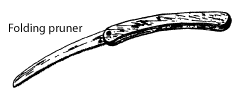
The folding pruner has a 10-inch curved blade with a
sure-grip
wood handle
that folds to protect the
cutting
edge.
The blade has 6/12 cross-cut
points
per inch,
and is 1 15/16 inches wide at
the butt,
and ½ inch
at the point.
Weight is ¾ pound.
This saw has a curved blade attached to a long extension handle and is used to prune high protruding limbs. The teeth face backward on the underside of the blade, so the cut is made on the pull stroke. The curved blade helps prevent binding and transfers the weight of the tool to the branch to aid cutting. Handles typically extend from 4 to 16 feet.
![]()
When using a pole saw, be aware of other workers nearby. Cut only those limbs whose ends you can see. Clear an area for dropping limbs. When cutting larger limbs, make two cuts. Begin with a slight cut on the underside of the branch to prevent bark from tearing when the limb is severed from the top.
Carry pole saws by your side. Grip the handle near the blade and point it away from your body and down. Long handles may require another worker to carry the tool farther back on the handle. Don't let the end of the handle drag on the ground.
Sharpen these saws with a slim taper file. Pole saws have alternately offset teeth that are beveled on both edges. Clamp the blade so the gullets are exposed about 1/8-inch to minimize chatter during sharpening. Align the file in the first gullet against the front and trailing edges of two adjacent teeth. The file should form an angle of about 65° with the blade. File every other gullet, then reverse direction and file alternate gullets at the same angle. Four or five strokes per tooth should suffice. File teeth equally; unevenly filed teeth will differ in height. The shorter teeth will be ineffective while cutting.
When transporting blades, provide a small protective box that holds approximately 10 to 15 blades vertically. Each blade should be separated by a ¼-inch plywood partition.
Examples:

The telescoping fiberglass tree pruner has
a
blade
that cuts
limbs
up
to 1¼ inches in
diameter.
The multipower pulley design
and
gear-driven
lever give three times more
cutting
power. The 16-inch
needle-point
saw
blade
cuts on
the pull stroke to reduce
binding.
Telescoping
fiberglass
pole adjusts
from
6 feet
to 12 feet.
Weight is 7 pounds.
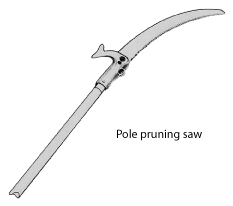
The 16-inch blade on this pole pruning saw
adjusts to
three different
positions on the
aluminum head. It has a large hook for
pushing branches,
raising ropes, etc. The
built-in pain
t brush holder applies tree
wound
paint.
The poles are 5 to 12 feet
long.
Weight is from 2 to 4 pounds
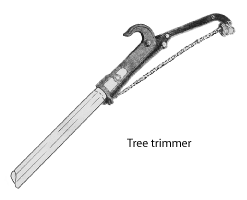
The strong, malleable iron pruner on this tree
trimmer
has
a steel chain
working through a
ballbearing pulley for a
powerful"center-cut"
action.
It cuts 1-inch diameter
limbs.
Poles
vary from 5 to 12 feet. Weight is
about 3 lbs.
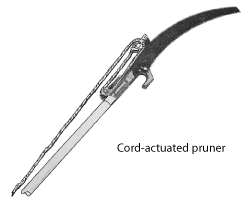
The cord-actuated pruner blade on this 15-foot long
pruner cuts
limbs
up to
1 1/8 inches in diameter.
A
multipower leverage system
increases
your pull
on the
cord 15 times for quick, easy cuts. The
16-inch
needle
point,
Teflon-coated saw blade cuts
on pull
strokes to
reduce
binding.
The three 5-foot
wooden
poles may be quickly
assembled
and
taken
apart.
Weight is 7 lbs.
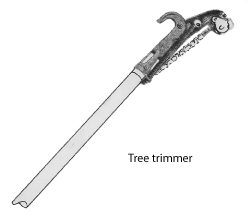
The head of this tree trimmer cuts limbs 1½ inches in
diameter.
This
heavy-duty, malleable, iron pruner
head
has a steel cable chain
that
works
through a ballbearing
pulley for a powerful, "center-cut" action.
The
poles
are 5 to 6 feet long. Weight is up to 4 pounds.
Use wedges as levers to prevent the sides of a cut from pinching a saw blade before the cut is finished. Most jobs require soft wedges that will not damage saw teeth. ABS plastic wedges are available in different lengths, widths, and weights. Some have metal inserts in the heads. Other types of wedges are designed to be used in combinations for felling. Wooden wedges are no longer used by the Forest Service.
Select the correct wedge for the job. Replace wedges when they become chipped or broken.
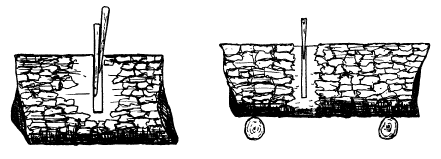
Using one or more wedges keeps a saw blade from being pinched.




